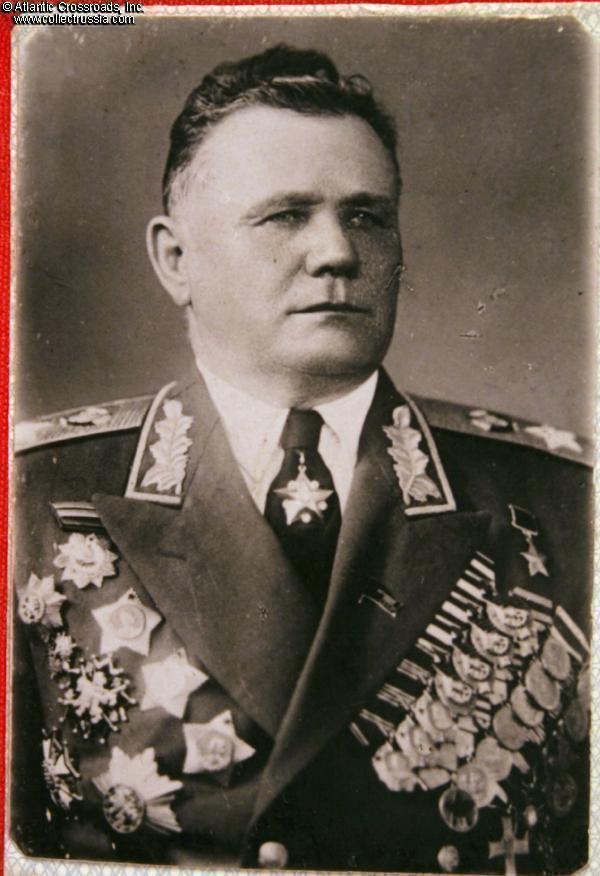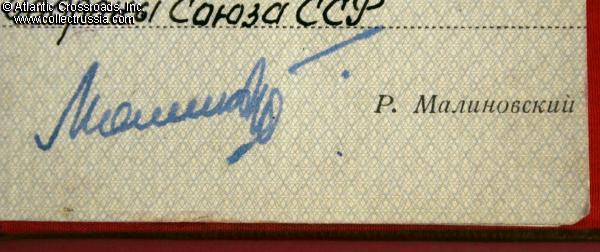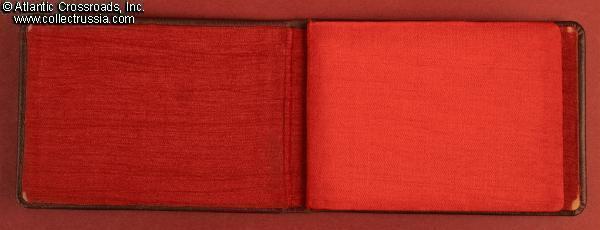
Military photo ID of Marshal of the Soviet Union Andrey Yeremenko, Inspector General for the Ministry of Defense of the USSR.
Medium brown extremely high quality morocco leather, lined in the finest red silk. Cover was once stamped with the Soviet star and the Russian word for "Certificate", both in gold. A photograph of the Marshal in full dress uniform wearing his orders and medals is contained inside, "tied" to the booklet by a strike with the official stamp of the Sovi
Medium brown extremely high quality morocco leather, lined in the finest red silk. Cover was once stamped with the Soviet star and the Russian word for "Certificate", both in gold. A photograph of the Marshal in full dress uniform wearing his orders and medals is contained inside, "tied" to the booklet by a strike with the official stamp of the Soviet Defense Minister.
Excellent condition. Being carried regularly by the Marshal for many years, the gold inscription on the cover eventually wore away but the imprint of the star and the lettering are both still clearly visible on the front.
Marshal of the Soviet Union Andrey Yeremenko, to whom this ID was issued, was born in the Ukraine in 1892. At the age of 21, he was drafted into the Imperial Russian army. Five years later he joined the Red Army as a cavalryman and spent the next two decades on horseback. His superiors recognized his leadership potential early on and he was sent to and graduated from the Frunze Military Academy in 1935.
By the outbreak of the Second World War, he was the commander of a cavalry corps and participated in the coordinated attack with the Germans on Poland. He was then transferred to the Soviet Far East; at the time of the German invasion of the Soviet Union in 1941, he was the commander of the Transbaikal Military District.
Within days of the Wehrmacht crossing the Soviet border, Yeremenko started on the first of several wartime transfers to go where the Red Army most needed his services. His first assignment was as the Acting Commander of the Soviet Western Front. His predecessor paid for his incompetence with his life but against all odds, Yeremenko managed to stop the German offensive at Smolensk. Wounded in the process, he was transferred to the Bryansk Front where he followed orders and mounted a virtually hopeless attack against the Germans in August that gained nothing.
His troops were more successful in slowing and then halting the German advance on Moscow in October (Operation Typhoon). In mid-October, he was wounded again and was out of action until January when he joined the North Western Front as the commander of the Fourth Shock Army. Almost immediately, a German air raid sent him back to the hospital!
In the summer of 1942, Yeremenko assumed command of the Southeastern Front as the Soviet Army endeavored to go on the offensive. Working with a political commissar named Krushchev, he made a large contribution to planning the defense of Stalingrad. And, like most successful Soviet commanders, he had no problem sacking subordinates: Lieutenant General Vasily Chuikov became the 62nd Army commander in September when Yeremenko realized that Chuikov's predecessor was not up to the task of holding Stalingrad at all costs.
The Soviets eventually encircled and destroyed the German 6th Army (and also halted a German counterattack under von Manstein). By spring of 1943, he was in the north at the Kalinin Front. In December, he became Commander of the Independent (Black Sea) Maritime Front, charged with taking the Crimea back from the Germans (which he did in collaboration with the 4th Ukrainian Front).
From the Crimea, he headed north to take command of the 2nd Baltic Front, where he was able to capture Dvinsk and Riga, effectively taking dozens of German divisions out of the war. His final wartime command was the 4th Ukrainian Front, liberating vast sections of Hungary and helping to liberate Czechoslovakia from the Germans.
In the decade after the defeat of Germany, he held three important commands in succession: Commander in Chief of the Carpathian Military District, Commander in Chief of the Western Siberian Military District, and Commander in Chief of the North Caucasus Military District. Promotion to the rank of Marshal of the Soviet Union came in 1955. His final position of responsibility in the Soviet Army was the one inscribed on this card: Inspector General for the Ministry of Defense. For the record, the position of Inspector General was not assigned without due consideration; the men who filled that office were generally feared not only by the rank and file but by the entire Soviet chain of command!
He died twelve years later and was honored in death by burial in the wall of the Kremlin in the Necropolis area behind Lenin's tomb on Red Square.
The rank of Marshal of the Soviet Union was created in 1935 by Josef Stalin and abolished in 1991. Only forty-one men ever held it and, as a result, everything that once belonged to any one of them has been of great interest to historians and collectors.
Andrey Yeremenko received three Orders of Suvorov, First Class, and a Gold Star Medal of Hero of the Soviet Union from his country in
recognition of his wartime efforts to defend the Motherland. (A comprehensive list of his Soviet and foreign honors appears in Kutsenko's
excellent over-sized book Marshals And Fleet Admirals Of The Soviet Union.) The fact that he also wore three wound stripes
(two of them for very serious wounds) also says a lot about what sort of person he must have been. This identification book represents a unique
opportunity to own a document that was in the personal possession of one of the highest ranking officers of the USSR.
$4,000.00 Add to cart








